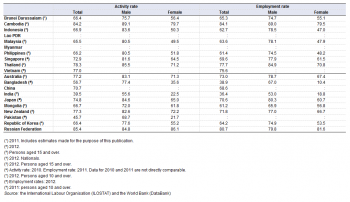Archive:Asia-Europe Meeting (ASEM) - a statistical portrait - labour market
- Data from July 2014. Most recent data: Further Eurostat information, Main tables and Database.
This article is part of a set of statistical articles based on Eurostat’s publication Asia-Europe Meeting (ASEM) — A statistical portrait.

(% of women aged 15–64) - Source: Eurostat (lfsi_act_a) and (lfsi_emp_a), the International Labour Organisation (ILOSTAT) and the World Bank (DataBank)

(% of persons aged 15–64) - Source: Eurostat (lfsi_act_a) and (lfsi_emp_a)

(% of persons aged 15–64) - Source: Eurostat (lfsi_emp_a), the International Labour Organisation (ILOSTAT) and the World Bank (DataBank)
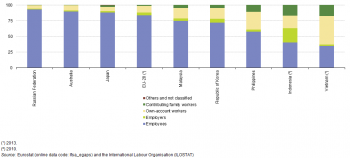
(%) - Source: Eurostat (lfsa_egaps) and the International Labour Organisation (ILOSTAT)
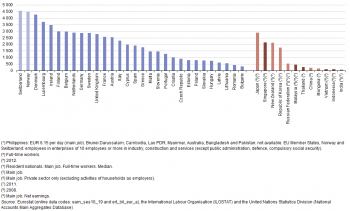
(EUR) - Source: Eurostat (earn_ses10_19) and (ert_bil_eur_a), the International Labour Organisation (ILOSTAT) and the United Nations Statistics Division (National Accounts Main Aggregates Database)
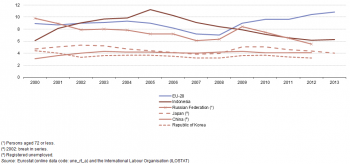
(unemployed persons aged 15–74 as a % of the labour force) - Source: Eurostat (une_rt_a) and the International Labour Organisation (ILOSTAT)

(%) - Source: Eurostat (une_rt_a) and the International Labour Organisation (ILOSTAT)

(unemployed persons as a % of the labour force) - Source: Eurostat (lfsa_urgan) and the International Labour Organisation (ILOSTAT)
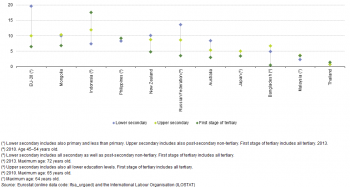
(unemployed persons aged 15–74 as a % of the labour force) - Source: Eurostat (lfsa_urgaed) and the International Labour Organisation (ILOSTAT)
This article focuses on labour market data about the European Union (EU), Norway and Switzerland in comparison with 20 Asian ASEM partners. It covers key indicators concerning the labour force, employment and earnings, and unemployment.
The use of the term European ASEM partners in this article refers to the 28 Member States of the EU, Norway and Switzerland. The use of the term Asian ASEM partners in this article refers to the 10 members of the Association of Southeast Asian Nations (ASEAN) and the 10 remaining ASEM partners referred to as Northeast and South Asia (NESA).
Main statistical findings
Labour force
The labour force — also known as the workforce or economically active persons — is made up of employed and unemployed persons. The activity rate is the share of economically active persons in the working-age population, while the employment rate is the share of employed persons in the working-age population. The difference between the two rates reflects the level of unemployment relative to the working-age population. There are many reasons for low activity rates, including a large proportion of the working-age population that is still studying, in early retirement, or not available for employment through long-term sickness, invalidity or caring for family members.
Figure 1 compares the activity and employment rates, focusing on women. The female activity rate among European ASEM partners and ASEAN members in 2013 was in a range between 50 % and 80 %, while for NESA the range was wider, with rates falling closer to one third (35.6 %) in Bangladesh and being situated between 20 % and 25 % in India and Pakistan. However, it should be noted that there are differences in the age coverage for some partners, including India and Pakistan.
Table 1 shows the activity and employment rates for all ASEM partners with a further analysis by sex: with the exception of the Russian Federation the activity and employment rates of men in 2013 were higher than for women in all ASEM partners.
Employment and earnings
The difference between the male and female employment rates is shown in Figure 2. Among the European ASEM partners the largest differences were in Malta, Greece and Italy: for the EU-28 as a whole the difference in 2013 was 10.6 percentage points. Among the Asian ASEM partners gender differences were generally greater, as only New Zealand, Cambodia and Mongolia (all 2012 data) reported gender differences that were below the EU-28 average, while in the Russian Federation the employment rate for women was higher than for men. By far the largest gender differences were observed for Bangladesh and India which reported particularly low employment rates for women.
The working status of persons in employment varied substantially between the ASEM partners as can be seen from Figure 3 which presents data for the EU-28 (data for 2013) and a selection of Asian ASEM partners (data mainly for 2012). The Russian Federation and Australia had higher proportions of paid employees than in the EU-28 and consequently fewer self-employed persons — referred to as employers (if having paid employees) or own-account workers — and fewer family workers. Japan also had a greater share of employees and combined this with a greater share of family workers and consequently recorded a lower share of self-employed persons. The other Asian ASEM partners shown in Figure 3 all displayed lower shares of paid employees and higher shares of self-employed and family workers. Indonesia (2010 data) stands out as its proportion of employers was greater than its proportion of own-account workers.
Comparing earnings between countries can be complicated by a number of issues, not least the fact that a conversion to a common currency using market exchange rates does not reflect the differences in purchasing power between countries. Other comparability issues relate to the accounting nature (whether gross or net of taxes and social security contributions), the type of workers or jobs covered (full-time or not, nationals or all residents, main job or also secondary jobs) and the type of employers (public or private sector). In 2010, average monthly earnings in the EU-28 were EUR 2 317, a level that was surpassed among the other ASEM partners in Norway and Switzerland as well as in Japan (see Figure 4).
Unemployment
Unemployed persons are those without work, but actively searching work. The unemployment rate is calculated as the number of unemployed persons as a proportion of the labour force (comprising all employed and unemployed persons).
Figure 5 provides an analysis of the development of unemployment rates in the EU-28 and five large ASEM economies since 2000. Unemployment and unemployment rates reflect economic developments, with a lag between output and unemployment: unemployment tends to start to rise after output has already fallen, while unemployment falls after output has started to increase. Just prior to the financial and economic crisis — around 2006 and 2007 — falling unemployment rates could be clearly seen for Indonesia, the EU-28, the Russian Federation and Japan. By 2009 this situation had reversed in the EU-28, the Russian Federation and Japan while the unemployment rate continued to fall in Indonesia. Unemployment rates for the Russian Federation and Japan returned to follow a downward path in 2010, while the rate for the EU-28 continued to climb through to 2013. Throughout this period, unemployment rates remained relatively low and stable in China and the Republic of Korea.
Male and female unemployment rates are presented in Figure 6: data are generally available for 2013, although earlier years are presented for many of the Asian ASEM partners. Unemployment rates were lower than the EU-28 average (10.8 % for men and 10.9 % for women) in Norway and Switzerland, as well as all of the Asian ASEM partners. In most ASEM partners, regardless of whether they were European or Asian, male and female unemployment rates were quite similar. The main exceptions were Greece, Pakistan and the Czech Republic where female rates were notably higher and Ireland and Lithuania where male rates were clearly higher.
In 2013, all ASEM partners had higher unemployment rates for younger persons (aged 15–24) than for the labour force as a whole, as can be seen in Figure 7. It should be remembered that these rates are calculated as a percentage of the labour force (not the population) and persons between the ages of 15 and 24 years may be outside of the labour force: young people are more likely to be studying full-time and therefore may not be available for work, while others may undertake activities outside of the labour market, such as travel.
The youth unemployment rate in the EU-28 reached 23.3 % in 2013, which was around 2.2 times as high as the overall EU-28 unemployment rate. The EU-28 average was brought down by a relatively low youth unemployment rate in Germany. The highest youth unemployment rates were reported for a group of southern and eastern EU Member States including Greece, Spain, Croatia, Italy, Cyprus, Portugal and Slovakia, all with rates above 30 %. Indonesia reported a youth unemployment rate of 21.6 %, while none of the other Asian ASEM partners (for which data are available) reported rates above 20 %. The youth unemployment rate was more than three times as high as the overall unemployment rate in Indonesia and Malaysia.
The likelihood of unemployment often differs depending on the level of education that someone has completed. Figure 8 provides information for the EU-28 and a selection of Asian ASEM partners for 2012, comparing unemployment rates for persons according to their highest level of education completed: note that rates are not shown for persons not having completed at least lower secondary education nor for those having completed higher levels of tertiary education. The EU-28, New Zealand, the Russian Federation, Australia and Japan (data for upper secondary education includes also all lower levels) displayed a similar pattern, with lower unemployment rates for those persons with higher levels of completed education. A similar situation was apparent in Mongolia and Bangladesh as the lowest unemployment rates were for persons having completed the first stage of tertiary education, although rates for persons having completed upper secondary education were higher than for those having completed at most lower secondary education. The reverse pattern was displayed for Indonesia, the Philippines and Thailand, as unemployment rates were highest for persons with higher levels of completed education; note that the unemployment rates in Malaysia and Thailand were below 5 % for all three levels of education.
Data sources and availability
The indicators presented are often compiled according to international — sometimes global — standards. Although most data are based on international concepts and definitions there may be certain discrepancies in the methods used to compile the data.
Almost all of the indicators presented for the EU (and its Member States), Norway and Switzerland have been drawn from Eurobase, Eurostat’s online database.
For the Asian ASEM partners and their aggregates (ASEAN and NESA), the data presented have been extracted from a range of international sources, namely the World Bank, the United Nations Statistics Division and the International Labour Organisation (ILO).
For many of the indicators multiple international statistical sources are available, each with their own policies and practices concerning data management (for example, concerning data validation, the correction of errors, the estimation of missing data, and the frequency of updating). In general, attempts have been made to use only one source for each indicator in order to provide a comparable analysis between the partners.
Aggregates for ASEM, the European ASEM partners and the Asian ASEM partners have been compiled from the data for individual partners as indicated above. As such, they may combine data from Eurostat and international sources.
Context
The labour market reflects the supply of labour by individuals and demand from businesses and other employers. Workers offer labour in return for remuneration (pay). Labour market indicators concern the levels of various types of employment and unemployment, as well as information concerning labour costs and earnings.
The economically active population is also known as the labour force. It is composed of employed and unemployed persons. Employed persons include employees, the self-employed (employers and own account workers) and family workers (persons who help another member of the family to run a farm, shop or other form of business). Economically inactive persons are neither employed nor unemployed, for example because they are studying, retired, unable to participate in the labour force or choose not to be a part of the workforce.
See also
- EU trade and investment statistics with the Association of South East Asian Nations (ASEAN)
- Asia-Europe Meeting (ASEM) — a statistical portrait
- Asia-Europe Meeting (ASEM) and EU — key statistical indicators
- The EU in the world
Further Eurostat information
Publications
- ASEM partners accounted for 44% of EU28 imports and 30% of exports in 2013 — News release October 2014
- EU trade in goods with India in slight deficit in 2015 for a third consecutive year — News release March 2016
- From birth to death: a closer look at business demography in selected EU countries and the Republic of Korea — Statistics in focus 1/2014
- Goods trade with ASEAN countries rebounds from 2009 to 2010 — Statistics in focus 47/2011
- EU-South Korea trade relations boosted by the recent free trade agreement — Statistics in focus 1/2015
- The EU in the world 2013 — A statistical portrait — Statistical book (2013)
- The European Union and the BRIC countries — Pocketbook (2012)
- The European Union and the Republic of Korea — A statistical portrait — Statistical book (2012)
Database
- Earnings, see:
- Structure of earnings survey 2010 (earn_ses2010)
- Monthly earnings (earn_ses10_mo)
- Mean monthly earnings by sex, economic activity and collective pay agreement (earn_ses10_19)
- Monthly earnings (earn_ses10_mo)
- LFS main indicators (lfsi)
- Population, activity and inactivity - LFS adjusted series (lfsi_act)
- Population, activity and inactivity - annual averages (lfsi_act_a)
- Employment - LFS adjusted series (lfsi_emp)
- Employment (main characteristics and rates) - annual averages (lfsi_emp_a)
- Unemployment - LFS adjusted series (une)
- Unemployment rate by sex and age groups - annual average, % (une_rt_a)
- Population, activity and inactivity - LFS adjusted series (lfsi_act)
- LFS series - Detailed annual survey results (lfsa)
- Employment - LFS series (lfsa_emp)
- Employment by sex, age and professional status (1 000) (lfsa_egaps)
- Total unemployment - LFS series (lfsa_unemp)
- Unemployment rates by sex, age and nationality (%) (lfsa_urgan)
- Unemployment rates by sex, age and highest level of education attained (%) (lfsa_urgaed)
- Employment - LFS series (lfsa_emp)
Dedicated section
Source data for tables and figures (MS Excel)
External links
- ASEM Infoboard – The official information platform of the Asia-Europe Meeting (ASEM)
- European Commission – DG International Development and Cooperation — EuropeAid: Building strong and lasting links with Asia
- European External Action Service (EEAS): European Union involvement in the Asia-Europe Meeting
